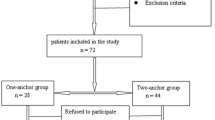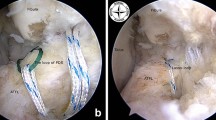Abstract
Purpose
To compare clinical function after knot anchor versus knotless anchor repair of the anterior talofibular ligament (ATFL) in patients with chronic lateral ankle instability.
Methods
All patients who underwent arthroscopic surgical ATFL repair using knot or knotless suture anchors were included in this study. Functional scores (American Orthopedic Foot and Ankle Society (AOFAS), Karlsson score and Tegner activity scores) and magnetic resonance imaging (MRI) were used to evaluate the ankle with a follow-up of at least 2 years.
Results
A total of 52 patients with chronic ankle instability were included in this study. Among these patients, 23 patients underwent one knot anchor repair procedure (Group A), and the other 29 patients underwent one knotless anchor repair procedure (Group B). At the final follow-up, there were no significant differences between Group A and Group B regarding the AOFAS score (89 ± 9 vs 84 ± 11; ns), Karlsson score (82 ± 14 vs 75 ± 18; ns), or Tegner activity score (4 ± 1 vs 4 ± 2; ns). There also were no significant differences in the mean ATFL signal–noise ratio (SNR) value (7.5 ± 4.4 vs 7.3 ± 2.9; ns) or ATFL angle (82° ± 7° vs 84° ± 9°; ns) between the groups.
Conclusion
When compared with knot repair, knotless repair of the lateral ankle ligament produced similar functional outcomes.
Level of evidence
III.





Similar content being viewed by others
References
Acevedo JI, Mangone P (2015) Arthroscopic Brostrom technique. Foot Ankle Int 36(4):465–473
Acevedo JI, Ortiz C, Golano P, Nery C (2015) ArthroBroström lateral ankle stabilization technique: an anatomic study. Am J Sports Med 43(10):2564–2571
Barber FA, Coons DA, Ruiz-Suarez M (2008) Cyclic load testing and ultimate failure strength of biodegradable glenoid anchors. Arthroscopy 24(2):224–228
Corte-Real NM, Moreira RM (2009) Arthroscopic repair of chronic lateral ankle instability. Foot Ankle Int 30(3):213–217
Cottom JM, Baker J, Plemmons BS (2018) Analysis of two different arthroscopic Brostrom repair constructs for treatment of chronic lateral ankle instability in 110 patients: a retrospective cohort study. J Foot Ankle Surg 57(1):31–37
Cottom JM, Rigby RB (2013) The "all inside" arthroscopic Brostrom procedure: a prospective study of 40 consecutive patients. J Foot Ankle Surg 52(5):568–574
Denard PJ, Adams CR, Fischer NC, Piepenbrink M, Wijdicks CA (2018) Knotless fixation is stronger and less variable than knotted constructs in securing a suture loop. Orthop J Sports Med 6(5):2325967118774000
Guillo S, Bauer T, Lee JW, Takao M, Kong SW, Stone JW et al (2013) Consensus in chronic ankle instability: aetiology, assessment, surgical indications and place for arthroscopy. Orthop Traumatol Surg Res 99(8 Suppl):S411–419
Hua Y (2018) Editorial commentary: repair of lateral ankle ligament: is arthroscopic technique the next station? Arthroscopy 34(8):2504–2505
Hua Y, Chen S, Li Y, Chen J, Li H (2010) Combination of modified Brostrom procedure with ankle arthroscopy for chronic ankle instability accompanied by intra-articular symptoms. Arthroscopy 26(4):524–528
Jarrett CD, McGillivary GR, Hutton WC (2010) The 2.5 mm PushLock suture anchor system versus a traditional suture anchor for ulnar collateral ligament injuries of the thumb: a biomechanical study. J Hand Surg Eur 35(2):139–143
Jiang D, Ao YF, Jiao C, Xie X, Chen LX, Guo QW et al (2018) Concurrent arthroscopic osteochondral lesion treatment and lateral ankle ligament repair has no substantial effect on the outcome of chronic lateral ankle instability. Knee Surg Sports Traumatol Arthrosc 26(10):3129–3134
Kim ES, Lee KT, Park JS, Lee YK (2011) Arthroscopic anterior talofibular ligament repair for chronic ankle instability with a suture anchor technique. Orthopedics 34(4):273
Kim SH, Crater RB, Hargens AR (2013) Movement-induced knot migration after anterior stabilization in the shoulder. Arthroscopy 29(3):485–490
Kocaoglu B, Guven O, Nalbantoglu U, Aydin N, Haklar U (2009) No difference between knotless sutures and suture anchors in arthroscopic repair of Bankart lesions in collision athletes. Knee Surg Sports Traumatol Arthrosc 17(7):844–849
Li H, Hua Y, Feng S, Li H, Chen S (2019) Lower signal intensity of the anterior talofibular ligament is associated with a higher rate of return to sport after ATFL repair for chronic lateral ankle instability. Am J Sports Med 47(10):2380–2385
Li H, Hua Y, Li H, Li S, Ma K, Chen S (2018) Treatment of talus osteochondral defects in chronic lateral unstable ankles: small-sized lateral chondral lesions had good clinical outcomes. Knee Surg Sports Traumatol Arthrosc 26(7):2116–2122
Li H, Hua Y, Li H, Ma K, Li S, Chen S (2017) Activity level and function 2 years after anterior talofibular ligament repair: a comparison between arthroscopic repair and open repair procedures. Am J Sports Med 45(9):2044–2051
Li HY, Li WL, Chen SY, Hua YH (2020) Increased ATFL-PTFL angle could be an indirect MRI sign in diagnosis of chronic ATFL injury. Knee Surg Sports Traumatol Arthrosc 28(1):208–212
Li SK, Song YJ, Li H, Wei B, Hua YH, Li HY (2018) Arthroscopic treatment combined with the ankle stabilization procedure is effective for sinus tarsi syndrome in patients with chronic ankle instability. Knee Surg Sports Traumatol Arthrosc 26(10):3135–3139
Li X, Killie H, Guerrero P, Busconi BD (2009) Anatomical reconstruction for chronic lateral ankle instability in the high-demand athlete: functional outcomes after the modified Brostrom repair using suture anchors. Am J Sports Med 37(3):488–494
Lui TH (2015) Modified arthroscopic Brostrom procedure. Foot Ankle Surg 21(3):216–219
Maffulli N, Del Buono A, Maffulli GD, Oliva F, Testa V, Capasso G et al (2013) Isolated anterior talofibular ligament Brostrom repair for chronic lateral ankle instability: 9-year follow-up. Am J Sports Med 41(4):858–864
Matheny LM, Johnson NS, Liechti DJ, Clanton TO (2016) Activity level and function after lateral ankle ligament repair versus reconstruction. Am J Sports Med 44(5):1301–1308
Matsui K, Takao M, Miyamoto W, Innami K, Matsushita T (2014) Arthroscopic Brostrom repair with Gould augmentation via an accessory anterolateral port for lateral instability of the ankle. Arch Orthop Trauma Surg 134(10):1461–1467
Ng DZ, Kumar VP (2014) Arthroscopic Bankart repair using knot-tying versus knotless suture anchors: is there a difference? Arthroscopy 30(4):422–427
Pearce CJ, Tourne Y, Zellers J, Terrier R, Toschi P, Silbernagel KG et al (2016) Rehabilitation after anatomical ankle ligament repair or reconstruction. Knee Surg Sports Traumatol Arthrosc 24(4):1130–1139
Pellegrini MJ, Sevillano J, Ortiz C, Giza E, Carcuro G (2019) Knotless modified arthroscopic-Brostrom technique for ankle instability. Foot Ankle Int 40(4):475–483
Pereira H, Vuurberg G, Gomes N, Oliveira JM, Ripoll PL, Reis RL et al (2016) Arthroscopic repair of ankle instability with all-soft knotless anchors. Arthrosc Tech 5(1):e99–e107
Petrera M, Dwyer T, Theodoropoulos JS, Ogilvie-Harris DJ (2014) Short- to medium-term outcomes after a modified Brostrom repair for lateral ankle instability with immediate postoperative weightbearing. Am J Sports Med 42(7):1542–1548
Shawen SB, Dworak T, Anderson RB (2016) Return to play following ankle sprain and lateral ligament reconstruction. Clin Sports Med 35(4):697–709
Takao M, Matsui K, Stone JW, Glazebrook MA, Kennedy JG, Guillo S et al (2016) Arthroscopic anterior talofibular ligament repair for lateral instability of the ankle. Knee Surg Sports Traumatol Arthrosc 24(4):1003–1006
Tassignon B, Verschueren J, Delahunt E, Smith M, Vicenzino B, Verhagen E et al (2019) Criteria-based return to sport decision-making following lateral ankle sprain injury: a systematic review and narrative synthesis. Sports Med 49(4):601–619
Vega J, Golano P, Pellegrino A, Rabat E, Pena F (2013) All-inside arthroscopic lateral collateral ligament repair for ankle instability with a knotless suture anchor technique. Foot Ankle Int 34(12):1701–1709
Willegger M, Benca E, Hirtler L, Hradecky K, Holinka J, Windhager R et al (2016) Biomechanical stability of tape augmentation for anterior talofibular ligament (ATFL) repair compared to the native ATFL. Knee Surg Sports Traumatol Arthrosc 24(4):1015–1021
Funding
This study was supported by the National Natural Science Foundation of China (81572209), Shanghai Excellent Talents Program (201609), and Shanghai Sports Science and Technology “Comprehensive Plan” Project (18Z004).
Author information
Authors and Affiliations
Corresponding author
Ethics declarations
Conflict of interest
The authors report no conflict of interest.
Ethical approval
The study was approved by the Health Sciences Institutional Review Board of Huashan Hospital. All procedures performed in studies involving human participants were in accordance with the ethical standards of the institutional and/or national research committee and with the 1964 Helsinki Declaration and its later amendments or comparable ethical standards.
Informed consent
Written consent was obtained from all participants.
Additional information
Publisher's Note
Springer Nature remains neutral with regard to jurisdictional claims in published maps and institutional affiliations.
Rights and permissions
About this article
Cite this article
Li, H., Zhao, Y., Hua, Y. et al. Knotless anchor repair produced similarly favourable outcomes as knot anchor repair for anterior talofibular ligament repair. Knee Surg Sports Traumatol Arthrosc 28, 3987–3993 (2020). https://doi.org/10.1007/s00167-020-05998-3
Received:
Accepted:
Published:
Issue Date:
DOI: https://doi.org/10.1007/s00167-020-05998-3




